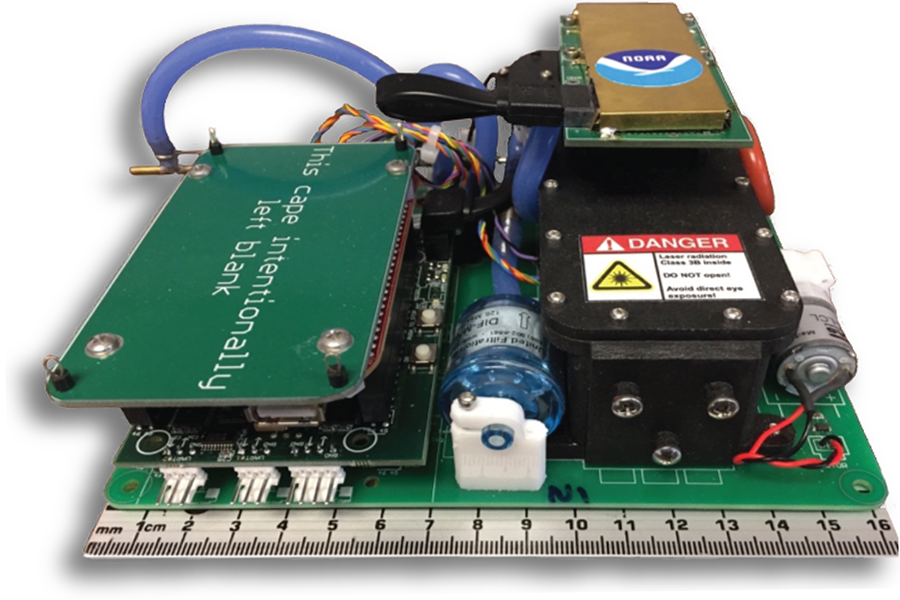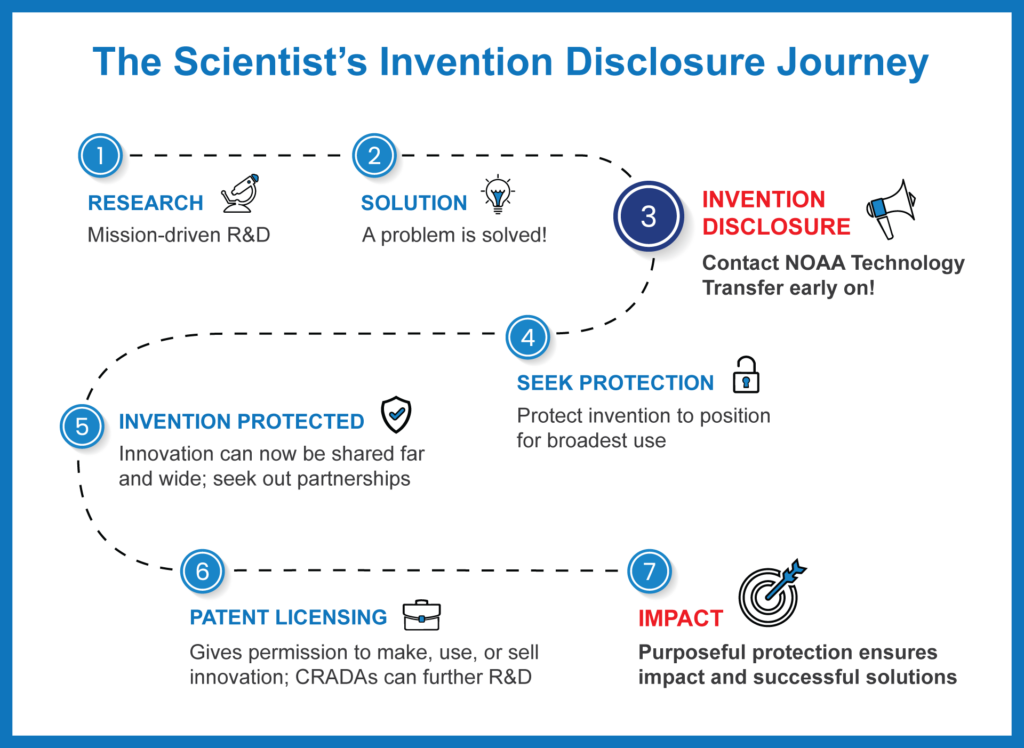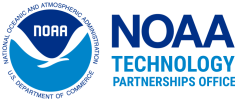
What is intellectual property, and why is it important?
When federal researchers and staff create or invent something, they also create intellectual property (IP). Intellectual property refers to creations of the mind that include artistic works, designs, and symbols. Just like physical property, intellectual property can be owned, bought and sold, shared, and protected. As public servants, NOAA employees have a responsibility to protect federally-funded IP. Intellectual property is an asset to NOAA, and like all assets owned by the federal government which are bought and paid for using taxpayer dollars, IP must be carefully managed and may not be given away without permission.
As with all federal employees and agencies, NOAA staff are required to report all IP created during the course of their employment through a process called invention disclosure. The requirement comes from Executive order 10096, the Stevenson-Wydler Technology Innovation Act of 1980, and the Federal Technology Transfer Act of 1986.
The NOAA Technology Partnerships Office (TPO) manages NOAA inventions and other forms of IP, and inventions are reported using the Intellectual Property/Invention Disclosure Form. There are many IP resources available to NOAA employees, including formal training materials and individualized consultation with IP professionals.
Why disclose your technology?
Invention disclosure is the critical first step in making sure your innovative technology achieves the broadest possible use and application. Your invention disclosure lets NOAA TPO:
- know your technology exists;
- understand what it does and how it might be used;
- know if it is mission-critical and if the intellectual property should be protected or not;
- provide you with recommendations for the best approach and steps to getting your technology used; and, if applicable,
- provide a public summary of your technology for the NOAA Technology Marketplace.
The few hours you invest now will return many dividends in the future as your innovative technology moves out of your lab and into broader use.
How do you know when your creation is an invention?
An invention is understood as a creation or solution of the mind, including products, devices, hardware, software, or improvements to these things. Guidelines to help researchers know when they have created an invention include:
- A problem has been solved: No products on the shelf currently meet this need.
- Your creation is new and unique: Commercial, off-the-shelf items have been combined in a new way to solve a problem.
- Your creation can be implemented: It can be built, tested, and useful
A recent example of an innovative technology that has successfully gone through the invention disclosure process is the Portable Optical Particle Spectrometer (POPS), designed and developed at NOAA’s Chemical Sciences Laboratory (CSL). POPS is a robust, small, lightweight, low-power, and relatively low-cost research-grade instrument used for measuring aerosol particle size and concentration in Earth’s atmosphere. By using the invention disclosure process, CSL was recognized with a NOAA Technology Transfer Award for helping a small company successfully commercialize the technology, which has led to over $1M+ sales for the company and multiple enhancements to CSL’s research and development capabilities.

Timing is critical!
Researchers should submit invention disclosures prior to publishing; but, even if they have already published, NOAA TPO encourages the submission of invention disclosures right away as they may be able to patent a variation of your invention. It is important to note that inventorship is not the same as authorship; but if you contributed to the conception of the invention, you deserve to be named as a joint inventor.

Publishing your work is not enough
While publishing your work is often considered the best means of sharing your IP, it is important to realize that it is not enough to just publish. Publishing research in a scientific journal disseminates knowledge, but it doesn’t empower the public to make practical use of that research without additional steps, such as pursuing patents, commercialization, collaborations with industry, and crafting simplified communication to the public. Reasons why publications alone are not enough can include:
1. Technical jargon and accessibility
Scientific papers are written for a specialized audience, often using highly technical language and concepts that are not easily understood by the general public. This creates a barrier to accessing and applying the information outside of academic or research settings. The general public, policymakers, and industry professionals often do not read or have access to scientific journals, which means even significant discoveries may not reach those who could benefit from or apply the findings.
2. No practical path to application
Simply publishing a research paper does not provide a clear path for how the findings can be turned into usable products, technologies, or solutions. Patents, collaborations with industry, and technology transfer offices are needed to bridge the gap between research and practical applications. Without securing intellectual property rights, such as patents, others may be hesitant to invest in the development of the research because there is no protection from competition. This lack of protection can stall the commercial development of new technologies.
3. No incentive for industry to act
Publishing in a journal does not give inventors or companies any proprietary rights to the research. Businesses often require a competitive advantage, such as a patent, to justify the investment in developing, scaling, and bringing an innovation to market. Industry players may be unsure how to collaborate or license the research if it is not backed by clear intellectual property protections. This limits the motivation for investment or real-world implementation.
4. Time-lag between discovery and application
Even if groundbreaking findings are published, it may take years or decades for the knowledge to translate into practical outcomes because of the slow process of knowledge diffusion. Without active efforts to promote, protect, and apply the research, the time between discovery and real-world impact is extended. Research often needs further refinement and adaptation to meet regulatory standards, market needs, or user requirements. Publishing alone does not drive this follow-up work, which is essential to turning a concept into a tangible product or service.
5. Public use requires practical guidance
The public often needs simplified explanations or applications for research to be useful. Publishing in a journal doesn’t provide the educational outreach necessary to help non-experts understand how to use or benefit from the research. Research papers focus on methods and results, but may not clearly outline the direct, practical benefits for public use, making it harder for individuals or organizations to see how they can leverage the findings.
TPO makes the process easy and transparent
The process of invention disclosure does not have to be daunting or time consuming. That is why NOAA TPO is here to help! Protecting IP is meant to support and encourage science, and employees who complete invention disclosures and engage in other IP-related activities will be recognized and celebrated. NOAA staff should disclose anything (hardware, software, or process) created from scratch or from existing parts, while they are on the job. If unsure, staff should contact NOAA TPO at NOAA.T2@noaa.gov and an IP expert will offer an opinion.
Visit the NOAA Technology Transfer Program website to view additional information about the program and available technologies. Contact NOAA TPO at NOAA.T2@noaa.gov to inquire about your invention or to request a consultation.
Note: Any reference obtained from this website to a specific company, product, process, or service does not constitute or imply an endorsement by NOAA.
Published on October 9, 2024 by Matthew Bryant
Media contact: alison.gillespie@noaa.gov

